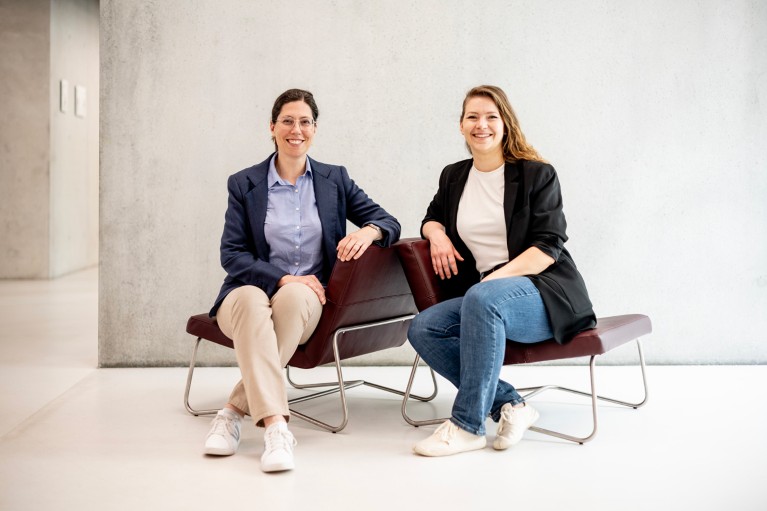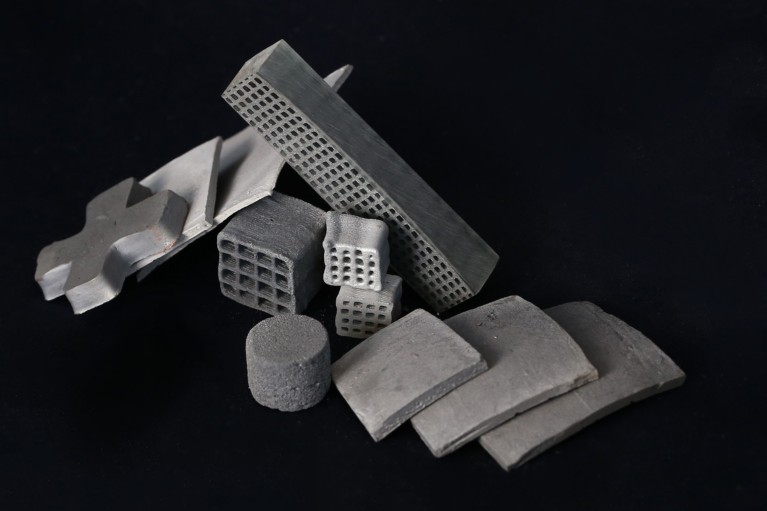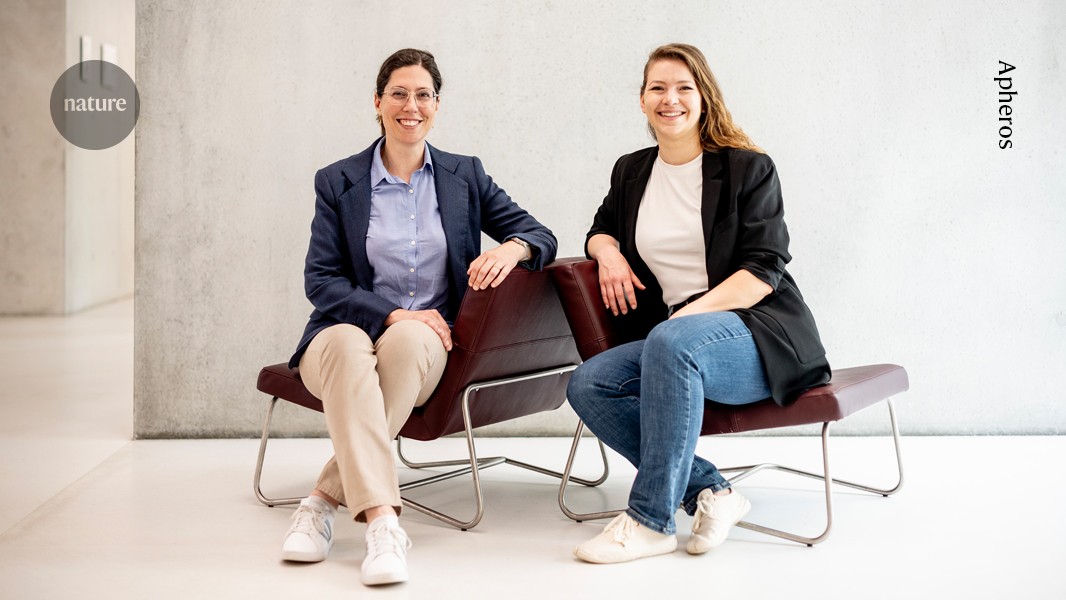
Gaëlle Andreatta (left) and Julia Carpenter are working to bring a new type of metal foam to market.Credit: Apheros
In August, the technology start-up Apheros announced a US$1.85-million funding round to develop a metal-foam-based cooling system for the world’s data centres, which are expected to account for an estimated 6% of global energy consumption by 2030. The company was established in 2023 as a spin-off from the Swiss Federal Institute of Technology (ETH) in Zurich, and was founded by Gaëlle Andreatta, the company’s chief technology officer, and Julia Carpenter, its chief executive. It now employs eight people and is based in Zurich.
Andreatta completed a PhD in chemistry at Pierre and Marie Curie University (now part of the Sorbonne University) in Paris in 2008. A year later, she joined Oxford Nanopore Technologies, a spin-off from the University of Oxford, UK, as a research scientist, and helped to develop and scale up the company’s biochip technology.
In 2013, she joined the Swiss Center for Electronics and Microtechnology (CSEM), based in Neuchâtel. The CSEM is a research institute that functions at the interface between applied science and industry, and is financed by partners in both the public and private sectors.
Over the ten years that followed, Andreatta worked on technology transfer for companies ranging from start-ups to large corporate firms, and in 2023, she embarked on an Executive Master of Business Administration (MBA) at the University of St Gallen in Switzerland.
Andreatta talks about the appeal of a corporate career, the value of having an Executive MBA alongside a PhD and how the roles of chief technology officer and chief executive fit together at Apheros.
She also addresses concerns raised by some female entrepreneurs about the impact of the collapse of the health-technology company Theranos in 2018. Theranos’s founder, Elizabeth Holmes, was convicted of defrauding investors in 2022, and its high-profile demise has reportedly made the funding climate more challenging for many female-led companies.
Why did you choose the corporate route over academia?
I was working on fundamental topics during my PhD and I really enjoyed my research projects. I developed a lot as a scientist, but I did not enjoy the ‘publish or perish’ mentality.
What I really wanted was to do good science and achieve results with a real-world impact. By the end of my PhD, I knew that I was not interested in pursuing a career as a postdoc and having to keep on publishing papers.
I knew that I might have a chance at a professorship if I continued down that route, but I was not so focused on achieving it. I felt I would have more impact doing research and develoment in industry settings.
When I joined Oxford Nanopore, the company was only four years old, and still very much at the development stage. It had the overarching goal of taking next-generation DNA-sequencing technology to market.
I really enjoyed playing a part in this as the technology moved towards commercialization. I took on an intermediate role between research and industry and sought out powerful new applications of the technology.
How did your MBA help you as entrepreneur?
I chose to do an 18-month part-time Executive MBA programme. These degrees are designed for people further on in their careers than is usually the case for standard MBAs — those who, like me, already have management experience, for instance. The course helped me to grasp the global picture of industry and commerce, and to look at business from different angles. It was also a chance to get a formal introduction to corporate finance and to build my understanding and confidence in this area, which is often missing when you come from a science background.
I learnt about business innovation and how to integrate a new technology into a company and the market, bearing in mind the firm’s strategic aims, the employees and the corporate culture.

Apheros’s innovative iron and iron-alloy foams.Credit: Apheros
The whole cohort had considerable experience, so we were able to coach each other, build and share our networks and develop a cooperative environment to help each other to see different perspectives and face new challenges.
I would compare it to research where you work in a bubble — the MBA enabled me to burst the bubble. Although the research role had shaped me, it was fantastic to move beyond that and to get a different perspective on business and communication. For me it was all about the people I met during my MBA, not just about learning in the classroom.
Tell us how you came to join forces with Julia Carpenter to create Apheros.
I was still at the CSEM when a mutual acquaintance told me about Julia and her idea to start a company to commercialize a new method of manufacturing metal foams with very large surface areas that she had developed during her PhD.
She had a list of the skills — including experience of scaling up, technology transfer and corporate finance, as well as applications knowledge — that she needed to help her realize her ambition. These exactly described my expertise. When I learnt more, my curiosity turned into real interest and passion.
How did you decide on your respective roles of chief executive and chief technology officer?
I’ve realized over the course of my career that titles are just titles. We have many responsibilities that fall outside the conventional roles — including finance and sales, for example. Essentially, we are just co-founders. We are very engaged in the business plan and keeping it on track — and, at the same time, scaling up and commercializing the technology.
Julia has an innate sense of how to interact with customers. We split our responsibilities; however, in a small company, everything overlaps. Therefore you have to be flexible while focusing on your own skill set.
What is your advice to young entrepreneurs, particularly female ones?
The key thing is to build grit and patience, and get over imposter syndrome — you don’t need to achieve perfection, but you do need to believe in yourself.
You also need to be passionate about what you do and believe that you are bringing something valuable to the table.
For me it is all about doing something that will improve lives, improve sustainability and translate my values into reality. So reflect deeply and go out confidently. It is about learning from failure and moving forwards.
Some female entrepreneurs say that the collapse of Theranos and Holmes’s fraud conviction have made it harder to attract funding. Is this your experience?
No, although I can see how it could have an impact. At the time we were seeking funding, we were already aware of a slump in investment in science and technology, and it was the same for all other entrepreneurs.
We were able to communicate our solid technical knowledge as a balanced team, and I think this gave our investors confidence in us.
But I would say that the situation is more difficult for women, because one bad apple can affect us all, unlike male entrepreneurs, who do not have to bear the same scrutiny if one of them did something illegal, such as fraud.
This emphasizes how much society expects women to be role models in their field and accepts nothing short of excellence.
On the positive side, Apheros does seem to attract a lot of female talent. I think this is partly a result of having two women heading up the company, which is rare in the technology field. Men in senior roles, I think, often find it harder to diversify their workforce and attract good female employees.
Representation is crucial. That includes having the confidence to voice concerns on issues that have a particular impact on women in the workplace. That is as important in industry as it is in academia.
Tell us more about Apheros’s technology and next steps.
Our process enables us to manufacture metal foams that are markedly different from conventional foams. It results in lightweight foams with a porosity of more than 90% and that are available in a wide range of materials, such as copper, iron and nickel. I like to compare the process to meringue-making.
We create an aqueous slurry, which is reshaped and thermally treated using an energy-efficient process. The material combines the conventional properties of a metal with high porosity. Our foams can be manufactured in bulk, which improves efficiency and lowers energy consumption.
The first application of our technology will be in the extraction of heat from data centres, for which good thermal transfer is key.
Cooling accounts for around 40% of data centres’ energy costs, so there is huge interest in our products. The technology is scalable and can easily replace existing methods. The raw materials and production method are highly sustainable.
We will use the $1.85 million we have raised to expand the team and to validate the technology — that is, to attain proof of concept — and then to scale it up.
I am passionate about bringing the technology into the real world and seeing its impact, so that the team can see its ideas coming to life. I don’t think there is any straightforward path to success, but having an idea you are passionate about is crucial.


